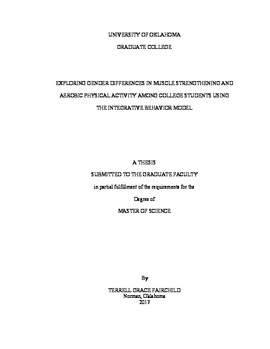| dc.description.abstract | Chronic diseases have become a serious problem for the people in the United States causing decreased quality of life, premature death, and rising health care costs (Bauer, et al. 2014). A primary way to lessen the risk of chronic disease is for individuals to participate in the government-recommended amount of aerobic and muscle strengthening physical activity (Bauer, et al. 2014). However, in 2013, only 50% of the adult population met the aerobic physical activity requirements, less than 30% met the muscle strengthening physical activity requirements, and barely 20% met the recommended amount for both types of activity (CDC, 2016b). Reports demonstrate that physical activity participation decreases across the lifespan with females participating in less physical activity than males (Beville, et al. 2014 & Hutchins, Drolet, and Ogletree, 2010). Aerobic physical activity has been the primary behavior observed in reported research, and researchers rarely focus on both aerobic and muscle strengthening physical activity together. Evaluating theory-based determinants of both types of physical activity among the college student population can provide insight to why this sub-population of adults does not meet both physical activity recommendations. The Integrative Behavior Model (IBM), which incorporates many well-known behavioral theories, has emerged as a promising novel theory that has not been extensively used in health behavior research. Therefore, the purpose of this study was to explore the differences in aerobic and muscle strengthening behaviors between male and female college students using the IBM.
Researchers developed the instrument used in this study, using guidance from the authors of the IBM, Icek Ajzen and Martin Fishbein. After the survey was developed, it was sent via email to all students at the University of Oklahoma currently enrolled in at least one credit hour. Pearson’s correlations were used to determine linear correlations between the IBM constructs, ANOVA’s were used to observe gender differences in demographics, multiple-linear regression models were used to analyze the determinants of intentions (attitudes, perceived behavioral control, and perceived norms), and logistic regression models were used to analyze the determinants of each physical activity behavior (intentions, skills, environmental constraints, and perceived behavioral control).
Contrary to what was expected, there were no significant differences between males and females with regards to meeting either of the physical activity requirements. Intentions was the only significant predictor for meeting either of the physical activity recommendations. The three primary constructs used to predict intentions, perceived behavioral control (PBC), perceived norms, and attitudes, were all significant. The sub-constructs experiential attitudes, instrumental attitudes, injunctive norms, descriptive norms, capacity, and autonomy all had different levels of influence on intentions that sometimes varied with gender. The determinants of attitudes, perceived norms, and PBC using indirect measures varied some between genders.
Using research based methods to understand one’s intentions and what drives them will help health professionals to develop programs, interventions, and policies that could be significant in changing behavior. The IBM is one of the newest and most comprehensive theories available for understanding health behaviors and how to influence them. This current study provides insight to ways of targeting intentions in this population of college students at the University of Oklahoma, which could be used to increase their physical activity behavior and therefore improve their overall health. | en_US |
